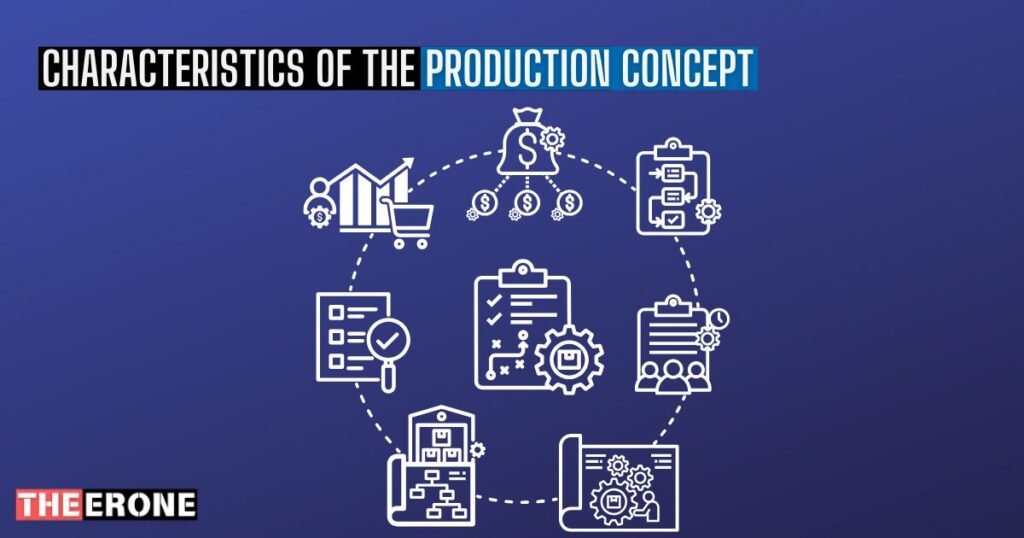The production concept is one of the oldest ideas in marketing history. It originated during the Industrial Revolution when industries needed to meet growing demands efficiently. Businesses then focused on producing large quantities at lower prices to attract customers.
This strategy relied on economies of scale and emphasized making products widely available and affordable. Understanding its origins helps explain how businesses developed strategies to balance cost, speed, and quality.
Even today, the production concept remains significant, and cost-cutting and meeting high demand are essential. It is instrumental in industries with affordable labour and high production needs.
The concept highlights the importance of accessibility and affordability in marketing. Studying its history shows how past practices influence modern business strategies.
The production concept’s roots tie directly to the global growth of supply chain systems and mass production models. It remains relevant in shaping marketing and business evolution over time.
What Is the Production Concept in Marketing?
The production concept in marketing emphasizes creating affordable products using efficient and cost-effective methods.
Businesses following this concept focus on operational excellence, large-scale manufacturing, and cost leadership to compete. High efficiency and low-cost production make products widely accessible to customers.
This approach relies on mass manufacturing to meet high demand at lower prices. Companies prioritize reducing production costs to sell goods affordably while maintaining reasonable quality.
Efficiency-driven practices ensure faster production and optimized resources, benefiting businesses and customers.
Examples of Production Concepts
The production concept focuses on delivering affordable products by maximizing efficiency and reducing costs. A classic example is Henry Ford’s assembly line, which revolutionized automobile manufacturing by making cars affordable for millions.
Similarly, fast-food chains like McDonald’s optimize production to serve standardized meals quickly and cost-effectively. Also, car manufacturers like Toyota use lean production methods to maintain cost leadership and operational excellence.
This strategy works best in industries where affordability and availability are key for customers.
Characteristics of the Production Concept

1. Focus on Cost Reduction
Cost reduction is key to the production concept. Companies lower manufacturing costs to provide affordable products, making goods accessible to more people while maintaining profitability through reduced expenses and higher sales volumes.
2. Mass Production
Mass production enables companies to produce goods on a large scale. This helps businesses meet high customer demand by creating more products quickly and efficiently while keeping prices affordable.
3. Affordability for Customers
The production concept ensures products are priced affordably. Lower prices attract more customers, increasing sales and customer satisfaction, making it a win-win for businesses and buyers.
4. Operational Efficiency
Efficient operations are vital in the production concept. Companies prioritize faster workflows, resource management, and streamlined processes to boost productivity and reduce the time taken to produce goods.
5. Standardized Products
Standardized products are a hallmark of this concept. By producing uniform goods, companies can ensure consistent quality, reliable distribution, and lower production costs for a wide range of offerings.
6. High Demand Orientation
Meeting high demand is essential in this approach. Businesses focus on manufacturing large quantities of products to satisfy market needs while keeping production seamless and timely.
7. Limited Customer Focus
The production concept has limited customer personalization. It prioritizes affordability and efficiency over customization, catering to general market demand rather than niche or individual preferences.
8. Resource Optimization
Optimizing resources is a key characteristic. Companies focus on efficiently using materials, time, and energy to reduce waste and maximize output, enhancing sustainability alongside profitability.
9. Scale Economies Advantage
Large-scale production offers economies of scale. Companies gain cost advantages as output increases, enabling them to lower per-unit production costs and price goods competitively.
10. Competitive Pricing
Competitive pricing is a priority in the production concept. Businesses offer products at market-leading prices, attracting budget-conscious customers while maintaining business profitability through streamlined operations.
These characteristics benefit industries aiming to produce affordable goods at competitive costs for wider audiences.
Origin of the Production Concept: How Old is It?
The production concept has roots in early societies focused on meeting basic needs. During pre-industrial times, people primarily made goods by hand for local communities.
Early capitalism began shaping production as trade and small local markets grew steadily. These early efforts showed the importance of resource efficiency, establishing a foundation for production ideas.
The 18th and 19th centuries saw massive shifts due to industrialization and innovation. The Industrial Revolution introduced machines that made manufacturing faster and more reliable.
Factories began replacing manual labour, increasing production output and reducing costs for goods. Industries scaled operations to serve global markets more effectively, which shaped modern production systems.
Henry Ford’s assembly line in 1913 made history by transforming how factories operated. Instead of workers building entire products, each focused on simple, repeatable tasks.
This method cut production time, lowered costs, and made items like cars affordable for regular people. Ford’s innovation remains a landmark event in manufacturing history and production efficiency.
The production concept evolved over centuries to prioritize efficiency, affordability, and large-scale manufacturing. Its history shows the impact of innovation in meeting growing consumer demands and shaping the world’s economy.
Pros and Cons of Production Concept
| Pros (Advantages) | Cons (Disadvantages) |
| Lower Costs– Companies make products cheaper by producing in large amounts. | Less Focus on Quality– The company cares more about making things fast than making them great. |
| More Products Available– Many products are made quickly, so people don’t have to wait. | Customer Needs Ignored– Businesses focus on making products, not on what customers really want. |
| Higher Profits– Lower costs mean companies can earn more money. | Old-Fashioned Approach– Today, people care about quality and experience, not just price. |
| Good for Basic Needs– Works well for things like food, clothes, and daily-use items. | Not Good for Competitive Markets– If customers have many choices, they will pick quality over price. |
| Encourages Innovation in Manufacturing– Pushes companies to find better ways to produce. | Customer Needs Ignored– Businesses focus on making products, not on what customers want. |
Principles of the Production Concept
The production concept focuses on making goods efficiently and reducing costs significantly. Businesses aim to produce in large quantities to achieve economies of scale, ensuring affordable goods for consumers.
A key approach under this concept is standardization, simplifying the production process by creating uniform products.
By keeping processes efficient and standardized, companies can deliver basic needs like food, clothing, and daily-use items quickly and affordably. This strategy is particularly effective in industries with high demand for low-cost products.
Evolution Over Time: Key Milestones

Pre-Industrial Revolution (Before 1760)
Before machines, goods were made on a small scale by skilled artisans. Production was slow and labor-intensive, resulting in expensive and limited products. Handmade goods were valued, but the absence of mechanization kept innovation minimal.
Industrial Revolution (1760-1840)
The Industrial Revolution brought machines, steam engines, and factories into production processes. Mass production began, allowing goods to be produced faster and cheaper. This era marked the transformation from manual labour to mechanized work, efficiently meeting the growing population’s needs.
20th Century (1900-1950s)
This period saw the rise of Fordism, which introduced assembly lines for large-scale production. The focus was on efficiency, offering standardized products at lower costs. However, customization was often sacrificed for the sake of speed and affordability.
Late 20th Century (1960s-1990s)
Lean manufacturing and Just-In-Time (JIT) production became important during this era. Companies minimized waste and optimized inventories by producing only what was needed. These methods improved efficiency and addressed changing customer preferences.
Modern-Day Production (2000s-Present)
Today’s production is highly automated, integrating AI and digital tools for flexible manufacturing. Advanced robotics and innovative technologies help create personalized products quickly and efficiently.
A shift towards sustainable practices also addresses environmental concerns while meeting consumer demand.
Modern production combines old efficiency models with new-age technologies to adapt to competitive markets successfully.
Why the Production Concept Still Matters Today
The production concept remains relevant as businesses seek to cut costs and improve efficiency. It allows companies to offer low-priced goods for customers in competitive markets.
Affordable and widely available products address basic consumer needs, making this concept crucial for essential goods industries. Businesses can scale quickly while maintaining reliability for buyers, giving them an edge over competitors.
How Businesses Still Use the Production Concept for Cost-Cutting
Many companies use the production concept to streamline manufacturing and reduce operational costs. By minimizing waste and efficiently using resources, businesses achieve affordable production without compromising quality.
Leading brands also emphasize bulk production, which lowers per-unit costs through economies of scale. Cost-cutting measures make goods more accessible, keeping loyal customers while attracting new ones.
Role of Technology in Making Production More Efficient
Technology plays a significant role in enhancing production efficiency and reducing errors. Automation has transformed manufacturing processes, ensuring faster outputs with greater precision.
AI and robotics optimize assembly lines, boosting productivity while cutting manual labour costs. Innovations such as supply chain optimization tools ensure smoother operations with fewer disruptions in production schedules.
Comparison with other marketing concepts
The table below helps explain the “production concept” and other marketing concepts in a simple way that’s easy to understand. It compares their main ideas and goals for businesses and consumers.
| Marketing Concept | Main Focus | Goal |
| Production Concept | Making goods quickly and cheaply. | To produce affordable products for many people. |
| Product Concept | High-quality and perfect products. | To satisfy customer needs with the best quality. |
| Selling Concept | Persuading people to buy products. | To boost sales using strong advertisements. |
| Societal Marketing Concept | Balancing customer needs with social good. | To create products that help society and the planet. |
This table shows how each marketing concept has a different way of helping businesses succeed. The production concept focuses on efficiency and low costs, while others prioritize quality, sales techniques, or social responsibility.
How Does the Production Concept Work?

The production concept focuses on making goods fast and at low costs. Businesses aim to create products that many people can afford. Production processes concentrate on efficiency and reducing waste to lower expenses.
Companies often rely on mass production to meet large-scale demand. The primary goal is to ensure products are widely available and affordable for consumers. This approach works best when people prioritize price over other factors, like quality or customization.
Challenges to the Production Concept
Today, many customers prefer unique, high-quality products over cheap, mass-produced items. Businesses must adapt to these changing expectations to stay competitive. Companies that ignore these trends might lose customers to competitors offering personalized options.
Mass production often leads to waste and environmental damage, raising serious concerns. Consumers value companies that use eco-friendly practices and reduce their carbon footprints. Businesses must now balance efficiency with sustainability to appeal to modern buyers.
New business trends focus on service solutions rather than just products. More companies now prioritize customer experience. Competition pushes businesses to rethink overly production-focused strategies. Offering excellent service or experiences can be a successful alternative.
Future of the Production Concept
1. Potential Adaptations in a Rapidly Evolving Global Economy
Global changes force companies to rethink how production happens. Businesses may shift to flexible models to adapt quickly. They might combine production efficiency with other concepts, like specialization.
2. Integration With Industry 4.0 Technologies
Advanced technology like robotics and AI can revolutionize production processes. These tools help improve efficiency without sacrificing quality. Businesses using innovative systems can better meet customer demands.
3. Speculation on the Continued Relevance of the Concept in the Age of Innovation
The production concept might remain helpful if combined with modern trends. Companies that evolve with technology and consumer expectations can still find success. While the world changes fast, affordability will always matter to buyers.
FAQs
When was the production concept first introduced?
The production concept was first introduced in the late 19th century during the industrial revolution. It focused on producing goods quickly and affordably to meet growing consumer demand.
What is an example of the production concept?
An example of the production concept is Ford’s Model T car, which used efficient manufacturing. This approach made cars affordable for everyday people and revolutionized mass production.
How does the production concept differ from the product concept?
The production concept focuses on affordability and availability, while the product concept prioritizes innovation. Businesses using the product concept aim to create high-quality goods with unique designs.
Is the production concept still relevant today?
The production concept is still relevant for industries offering affordable and essential goods. It works best in areas where consumers prioritize cost efficiency over premium features.
Conclusions
The production concept remains an enduring philosophy in business, centering on efficiency and affordability. However, as the global economy evolves and customer expectations grow, companies must adapt this approach to thrive.
Businesses can ensure that the production concept stays relevant by integrating innovative technologies, prioritizing adaptability, and balancing efficiency with quality and customer needs.
Ultimately, success lies in blending traditional values of cost-effectiveness with modern advancements, creating solutions that meet operational goals and consumer satisfaction in an increasingly competitive marketplace.










